PRINCETON, NJ -- The current political landscape, with the percentage of those identifying themselves as Democrats outnumbering those who identify as Republicans by a 37% to 28% margin, provides a significant advantage for Barack Obama's presidential chances.
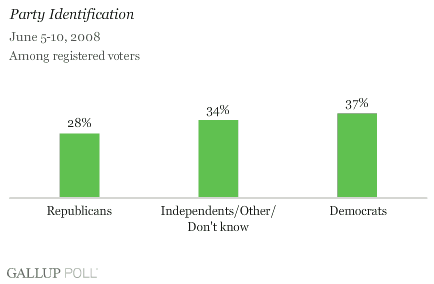
These data are based on 5,299 interviews with registered voters conducted as part of ║┌┴¤═° Poll Daily tracking during the six-day period of June 5-10, representing the period since the general-election matchup of Obama versus John McCain became definite. Thirty-seven percent of Americans identify themselves as Democrats, compared to 28% who identify as Republicans. Another 34% say they are independents and don't choose (in response to this initial question) to identify with either party.
Following very well-established patterns in American presidential elections, voter identification as a Republican or Democrat is strongly -- but not totally -- correlated with support for the two parties' candidates.
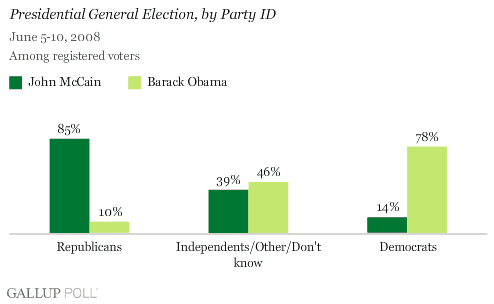
Those who identify as Republicans at this juncture appear to be a bit more loyal to their party's candidate, with 85% supporting McCain, compared to the 78% of those who identify as Democrats supporting Obama. Looked at differently, Democrats have a slightly higher defection rate -- at this point -- than do Republicans. (Although these data were collected after Hillary Clinton's announcement that she was suspending her campaign, it is possible that the Democratic defection rate represents some residual anger among Clinton-supporting Democrats, anger that may dissipate between now and November.)
Independents -- who initially do not identify with either party -- break toward Obama by a 46% to 39% margin. (McCain and Obama have been competitive for the independent vote since March.)
When all of these data for June 5-10 are put together, the overall vote pattern for this period among registered voters is a six-point margin for Obama over McCain, 48% to 42%. The margin is in Obama's favor in part because there are more Democrats than Republicans in the sample, which helps compensate for the fact that Democrats are slightly less loyal to Obama than are Republicans to McCain. Obama's margin is also based on Obama's ability to swing independents slightly in his direction.
Hypothetically speaking, if there were no independents in the race, Obama would still win by a five-point margin, 49% to 44% -- reflecting the higher percentage of Democratic identifiers in the voting population.
All in all, for McCain to win the popular vote in November, some combination of the following would need to occur:
- An increase in the percentage of the voting population who identify as Republicans
- An increase in the percentage of Republicans who support McCain
- An increase in the percentage of the vote McCain receives from those who identify as Democrats
- An increase in the support McCain receives among independents
- A much higher turnout rate for McCain supporters than for Obama supporters
It appears that McCain's chances of increasing his support among independents may not be extremely high. The accompanying table shows the split when the 34% who are independents are asked if they "lean" one way or the other.
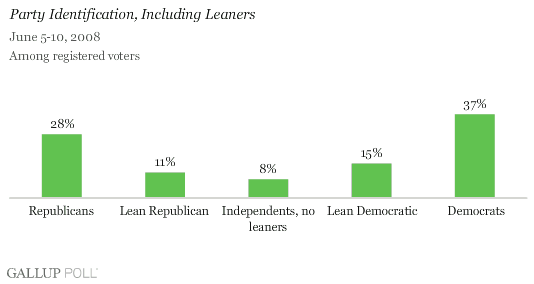
This more detailed analysis provides a better understanding of why Obama is leading among independents. When pressed to say which way they lean, independents tilt toward identifying with the Democratic Party by a significant margin. The 34% independent segment breaks down into 15% who lean Democratic, 11% who lean Republican, and 8% who remain "pure" independents and refuse to indicate which way they lean. Looked at differently, 44% of the initial independent segment leans Democratic, compared to just 33% who lean Republican.
These "leaners" are essentially as loyal to their party's candidate as are those who initially identified with a party without being prompted.
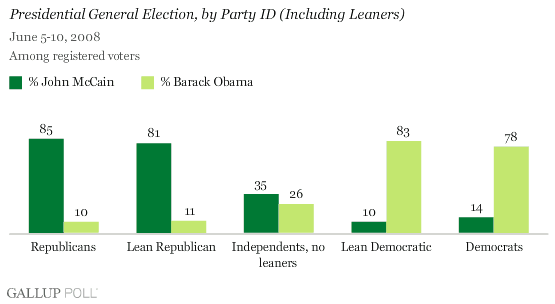
Eighty-one percent of independents who lean Republican support McCain, while 83% of those who lean Democratic support Obama.
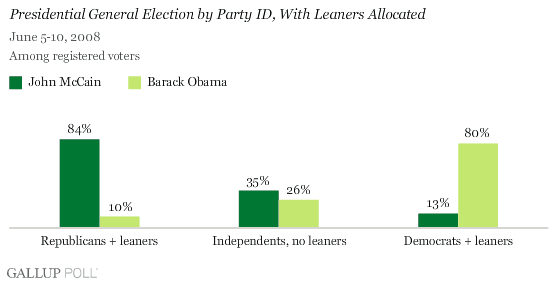
Thus, all in all, this profile of the relationship between party identification with leaners allocated and vote choice reveals a situation similar to the situation before leaners are allocated. McCain gets a slightly higher 84% of Republicans with leaners than Obama's 80% of Democrats with leaners, but the significantly higher percentage of Democrats in the electorate gives Obama his overall edge.
What about the small sliver of "pure independents" who refuse to admit that they lean toward one party or the other? This group constitutes only 8% of the voting electorate, and is largely an apolitical group. They are much more likely to be undecided than other voters, but the basic tilt is 35% to 26% for McCain over Obama. This, of course, is not nearly enough to compensate for the large number of Democratic identifiers.
Implications
At this point, Obama's lead in the general-election popular vote is correlated with the fact that there are more American voters who identify themselves as Democrats than as Republicans. This allows Obama to compensate for the slightly smaller percentage of those identifying as Democrats who support him than is the case for Republicans who support McCain. Obama is further helped by the fact that voters who initially identify as independents are more likely to lean toward identifying as Democrats than to lean toward the Republican Party. McCain does have a slight edge among pure independents, but this is not enough to compensate for these other dynamics.
Survey Methods
Results are based on telephone interviews with 5,299 registered voters, aged 18 and older, conducted June 5-10, 2008. For results based on the total sample of national adults, one can say with 95% confidence that the maximum margin of sampling error is ┬▒2 percentage points.
Interviews are conducted with respondents on land-line telephones (for respondents with a land-line telephone) and cellular phones (for respondents who are cell-phone only).
In addition to sampling error, question wording and practical difficulties in conducting surveys can introduce error or bias into the findings of public opinion polls.
To provide feedback or suggestions about how to improve ║┌┴¤═°.com, please e-mail feedback@gallup.com.
